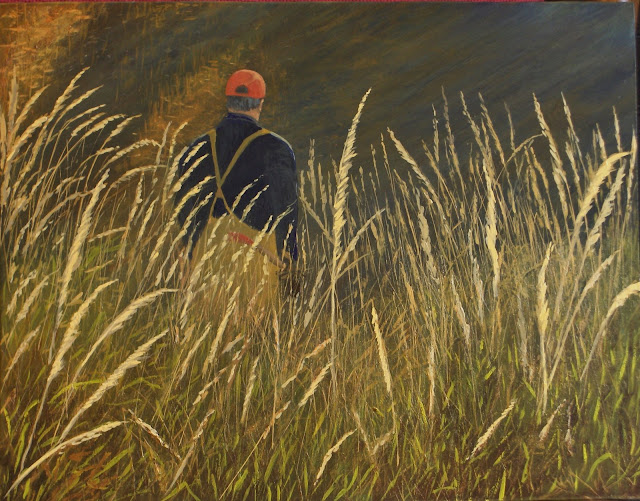 I cropped a piece of the original photo and chose a format that I thought would work for my painting. I want to emphasize the sky but at this point I am not sure if I will have a cloudless sky or not.
I cropped a piece of the original photo and chose a format that I thought would work for my painting. I want to emphasize the sky but at this point I am not sure if I will have a cloudless sky or not. I sealed an 11" x 14" piece of hardboard panel with acrylic matte medium. Then I put a cerelium blue tinted gesso layer on and let dry. I sanded it and then put a crimson-pinkish color gesso on but allowing some of that cerelium blue color uncovered. To the left over gesso I added thalo blue and Payne's grey . I sketched in where the horizon line would be at aprox the 1/4 length of the panel. I laid this dark blue gesso layer along the bottom portion below the horizon line. Then while the dark gesso was still wet, I laid plastic wrap on the area and lifted it off pulling downward. It left these wave like ripples in the gesso. I had to refine it a bit with a palette knife but I liked the result. It was experimental, but it gave what was the beginning of a wave like texture in this water area of the painting.
I sealed an 11" x 14" piece of hardboard panel with acrylic matte medium. Then I put a cerelium blue tinted gesso layer on and let dry. I sanded it and then put a crimson-pinkish color gesso on but allowing some of that cerelium blue color uncovered. To the left over gesso I added thalo blue and Payne's grey . I sketched in where the horizon line would be at aprox the 1/4 length of the panel. I laid this dark blue gesso layer along the bottom portion below the horizon line. Then while the dark gesso was still wet, I laid plastic wrap on the area and lifted it off pulling downward. It left these wave like ripples in the gesso. I had to refine it a bit with a palette knife but I liked the result. It was experimental, but it gave what was the beginning of a wave like texture in this water area of the painting.

I put my first acrylic paint layer on using cobalt blue, Payne's grey, white and pthalo green for the water. For the sky I used cobalt blue, crimson, naples yellow and white blending in such a way as to get a transition from blue at the top to that orange color at the bottom.

I painted in the distant land and islands and then glazed the entire panel with a mixture of yellow ochre and cad yellow light. It looks a little too green on the water at this point but that's OK . I will follow it with a crimson glaze.

This painting was a good exercise, but I am not happy with the basic composition. I left it as is, and I am still calling it, unfinished.It does show the wide open space of the Newfoundland waters, and this is what I will call 'Fishing Grounds' and maybe that is what I captured most. Maybe others will like it .. but, I am dissatisfied with it for some reason.






 I added the orange dot at the location where the head would be. This gives me an idea as I proceed , where the figure will be in relation to the background.
I added the orange dot at the location where the head would be. This gives me an idea as I proceed , where the figure will be in relation to the background.

 I made a glaze mixture with
I made a glaze mixture with 












